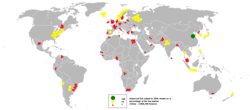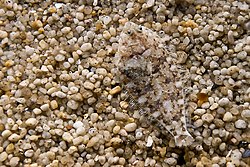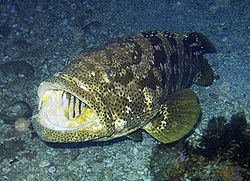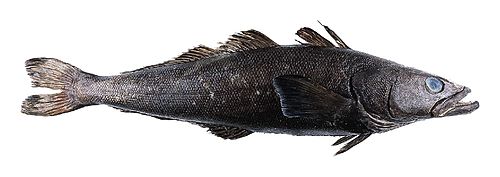Demersal fish

Demersal fish, also known as groundfish, live and feed on or near the bottom of
Demersal fish are bottom feeders. They can be contrasted with pelagic fish, which live and feed away from the bottom in the open water column. Demersal fish fillets contain little fish oil (one to four per cent), whereas pelagic fish can contain up to 30 per cent.[not verified in body]
Types
Demersal fish can be divided into two main types: strictly benthic fish which can rest on the sea floor, and benthopelagic fish which can float in the water column just above the sea floor.
Benthopelagic fish have neutral buoyancy, so they can float at depth without much effort, while strictly benthic fish are denser, with negative buoyancy so they can lie on the bottom without any effort.[2] Most demersal fish are benthopelagic.[1]
As with other bottom feeders, a mechanism to deal with
Benthic fish
Benthic fish are denser than water, so they can rest on the sea floor. They either lie-and-wait as
.-
Flounder have both eyes on one side of their head
-
Some flatfish can camouflage themselves on the ocean floor
-
Bluespotted ribbontail rays migrate in schools onto shallow sands to feed on mollusks, shrimps, crabs and worms.[5]
-
The great hammerhead detects the electrical signatures of stingrays buried in the sand and pins them with its "hammer".[6]
Flounder ambush their prey, feeding at soft muddy area of the sea bottom, near bridge piles, docks, artificial and coral reefs. Their diet consists mainly of fish spawn, crustaceans, polychaetes and small fish.
The great hammerhead swings its head in broad angles over the sea floor to pick up the electrical signatures of stingrays buried in the sand. It then uses its "hammer" to pin down the stingray.[7]
-
Pacific hagfish resting on bottom. Hagfish coat themselves and any dead fish they find with noxious slime making them inedible to other species.
-
The tripodfish (Bathypterois grallator), a species of spiderfish, uses its fin extensions to "stand" on the bottom.[8]
-
The fringe-lipped flathead is found in estuaries
Some fishes do not fit into the above classification. For example, the family of nearly blind
The bodies of benthic fish are adapted for ongoing contact with the sea floor. Swimbladders are usually absent or reduced, and the bodies are usually flattened in one way or another.[10] Following Moyle and Cech (2004) they can be divided into five overlapping body shapes:[10]
| Body types of benthic fish | ||
|---|---|---|
| Bottom rovers | Bottom rovers "have a rover-predator-like body, except that the head tends to be flattened, the back humped, and the pectoral fins enlarged. North American catfish with large mouths at the end of the snout, small armoured catfish with small mouths beneath the snout, and sturgeons, with fleshy protusible lips located well below the snout that are used to suck plant and animal matter off the bottom."[11] | |
| Bottom clingers |  |
Bottom clingers "are mainly small fish with flattened heads, large pectoral fins, and structures (usually modified pelvic fins) that enable them to adhere to the bottom. Such structures are handy in swift streams, or intertidal areas with strong currents. The simplest arrangement is possessed by clingfishes have evolved suction cups."[11]
|
| Bottom hiders |  |
Bottom hiders "are similar in many ways to bottom clingers. but they lack the clinging devices and tend to have more elongate bodies and smaller heads. These forms usually live under rocks or in crevices or lie quietly on the bottom in still waters. The blennies."[11]
|
| Flatfish |  |
Flatfish "have the most extreme morphologies of the bottom fish. |
| Rattail-shaped fish | Rattail-shaped fish "have bodies that begin with large pointy-snouted heads and large | |
Benthopelagic fish
Benthopelagic fish inhabit the water just above the bottom, feeding on benthos and zooplankton.[15] Most demersal fish are benthopelagic.[1]
Deep sea benthopelagic
Benthopelagic sharks, like the deep sea
Shallow water stingrays are benthic, and can lie on the bottom because of their negative buoyancy. Deep sea stingrays are benthopelagic, and like the squaloids have very large livers which give them neutral buoyancy.[2]
Benthopelagic fish can be divided into flabby or robust body types. Flabby benthopelagic fishes are like
Deepwater benthopelagic fish are robust, muscular swimmers that actively cruise the bottom searching for prey. They often live around features, such as seamounts, which have strong currents.[19] Commercial examples are the orange roughy and Patagonian toothfish.
Habitats

The edge of the
The term bathydemersal fish is sometimes used instead of "deep water demersal fish". Bathydemersal refers to demersal fish which live at depths greater than 200 metres.
The term epibenthic is also used to refer to organism that live on top of the ocean floor, as opposed to those that burrow into the seafloor substrate. However the terms mesodemersal, epidemersal, mesobenthic and bathybenthic are not used.
Coastal
Coastal demersal fish are found on or near the seabed of coastal waters between the
.-
Themangrove jack eats crustaceans
-
Manymolluscs
-
The venomousbenthic ambush predator, blends into sandy or muddy bottoms.[21]
-
Triggerfish use a jet of water to uncover sand dollars buried in sand
Young

Other examples of coastal demersal fish are
Deep water

Deep water demersal fish occupy the benthic regions beyond the continental margins.
On the
The bodies of deep water demersal fishes are muscular with well developed organs. In this way they are closer to
Deep sea demersal fish are usually long and narrow. Many are eels or shaped like eels. This may be because long bodies have long lateral lines. Lateral lines detect low-frequency sounds, and some demersal fishes have muscles that drum such sounds to attract mates.[29] Smell is also important, as indicated by the rapidity with which demersal fish find traps baited with bait fish.
The main diet of deep sea demersal fish is invertebrates of the deep sea benthos and carrion. Smell, touch and lateral line sensitivities seem to be the main sensory devices for locating these.[3]
Like coastal demersal fish, deep sea demersal fish can be divided into benthic fish and benthopelagic fish, where the benthic fish are negatively buoyant and benthopelagic fish are neutrally buoyant.[3]
The availability of plankton for food diminishes rapidly with depth. At 1,000 metres (3,300 ft), the biomass of plankton is typically about 1 per cent of that at the surface, and at 5,000 metres (16,000 ft) about 0.01 per cent.[16] Given there is no sunlight, energy enters deep water zones as organic matter. There are three main ways this happens. Firstly, organic matter can move into the zone from the continental landmass, for example, through currents that carry the matter down rivers, then plume along the continental shelf and finally spill down the continental slope. Other matter enters as particulate matter raining down from the overhead water column in the form of marine snow, or as sinking overhead plant material such as eelgrass, or as "large particles" such as dead fish and whales sinking to the bottom. A third way energy can arrive is through fish, such as vertically migrating mesopelagic fishes that can enter into the demersal zone as they ascend or descend. The demersal fish and invertebrates consume organic matter that does arrive, break it down and recycle it. A consequence of these energy delivery mechanisms is that the abundance of demersal fish and invertebrates gradually decrease as the distance from continental shorelines increases.[30]
Although deep water demersal fish species are not generally picky about what they eat, there is still some degree of specialisation. For example, different fish have different mouth sizes, which determines the size of the prey they can handle. Some feed mostly on benthopelagic organisms. Others fed mostly on
Some feed on carrion. Cameras show that when a dead fish is placed on the bottom, vertebrate and invertebrate scavengers appear very quickly. If the fish is large, some scavengers burrow in and eat it from the inside out. Some fish, such as
At great depths, food scarcity and extreme pressure limits the ability of fish to survive. The deepest point of the ocean is about 11,000 metres.
The deepest-living fish known, the strictly benthic Abyssobrotula galatheae, eel-like and blind, feeds on benthic invertebrates. A living example was trawled from the bottom of the Puerto Rico Trench in 1970 from a depth of 8,370 metres (27,453 ft).[37][38]
In 2008, a shoal of 17 hadal snailfish, a species of deep water snailfish, was filmed by a UK-Japan team using remote operated landers at depths of 7.7 km (4.8 mi) in the Japan Trench in the Pacific. The fish were 30 centimetres long (12 in), and were darting about, using vibration sensors on their nose to catch shrimps. The team also reported that the appearance of the fish, unlike that of most deep sea fish, was surprisingly "cute", and that they were surprised by how active the fish were at these depths.[39][40]
Demersal fisheries
This section needs to be updated. (November 2017) |
Most demersal fish of commercial or recreational interest are coastal, confined to the upper 200 metres. Commercially important demersal
The following table shows the world capture production of some groups of demersal species in tonnes.[42]
| Capture production by groups of species in tonnes | ||||||||
|---|---|---|---|---|---|---|---|---|
| Group | 1999 | 2000 | 2001 | 2002 | 2003 | 2004 | 2005 |  |
| Cods, hakes, haddocks | 9,431,141 | 8,695,910 | 9,304,922 | 8,474,044 | 9,385,328 | 9,398,780 | 8,964,873 | |
| 956,926 | 1,009,253 | 948,427 | 915,177 | 917,326 | 862,162 | 900,012 | ||
| Other demersal fishes | 2,955,849 | 3,033,384 | 3,008,283 | 3,062,222 | 3,059,707 | 3,163,050 | 2,986,081 | |
-
American plaice are usually found between 90 and 250 metres (but have been found at 3000 m). They feed on small fishes and invertebrates.[44]
-
Atlantic cod are usually found between 150 and 200 metres, they are omnivorous and feed on invertebrates and fish, including young cod.[45]
-
Grouper are ambush predators with a powerful sucking system that sucks their prey in from a distance
Grouper are often found around reefs. They have stout bodies and large mouths. They are not built for long-distance or fast swimming. They can be quite large, and lengths over a meter and weights up to 100 kg are not uncommon. They swallow prey rather than biting pieces off it. They do not have many teeth on the edges of their jaws, but they have heavy crushing tooth plates inside the pharynx. They lie in wait, rather than chasing in open water. They are found in areas of hard or consolidated substrate, and use structural features such as ledges, rocks, and coral reefs (as well as artificial reefs like wrecks and sunken barges) as their habitat. Their mouth and gills form a powerful sucking system that sucks their prey in from a distance. They also use their mouth to dig into sand to form their shelters under big rocks, jetting it out through their gills. Their gill muscles are so powerful that it is nearly impossible to pull them out of their cave if they feel attacked and extend those muscles to lock themselves in. There is some research indicating that roving coral groupers (Plectropomus pessuliferus) sometimes cooperate with giant morays in hunting.[46]
-
The Patagonian toothfish is a robust benthopelagic fish
-
The orange roughy is also a robust benthopelagic fish
-
Thesustainable fishing industry in New Zealand.[47]
Deepwater benthopelagic fish are robust, muscular swimmers that actively cruise the bottom searching for prey. They often live around features, such as seamounts, which have strong currents.[19] Commercial examples are the orange roughy and Patagonian toothfish. Because these fish were once abundant, and because their robust bodies are good to eat, these fish have been commercially harvested.[48][49]
Conservation status
| This article is part of a series on |
| Commercial fish |
|---|
| Large predatory |
| Forage |
| Demersal |
| Mixed |
Major demersal fishery species in the
as "outside safe biological limits."The by-catch problem
A major problem in conservation of demersal fish populations is that of by-catch, whereby fish are caught by accident when targeting other species. The European Commission has written that “A key issue is that many of the most important demersal stocks (i.e. those that live on or near the bottom of the sea) are caught in mixed fisheries. In practice, this means that each time a vessel retrieves its fishing gear, its catch will consist of a mix of different species.”[50] This has led to a situation whereby, even when the International Council for the Exploration of the Sea recommends a Total Allowable Catch of zero for a given demersal species in order to allow replenishment of population, the European Council nonetheless sets the Total Allowable Catch far above zero so long as the catch is by-catch, in order not to prevent trawlers fishing for other species.[51] This means that those threatened species do not get the chance to replenish even when not directly targeted by trawlers.
- The Common Sole, Biodiversity Action Plan.
- Sole, along with the other major bottom-feeding fish in the North Sea such as cod, monkfish, and plaice, is listed by the World Wildlife Fund in 2006, "of the nine sole stocks, seven are overfished with the status of the remaining two unknown." Data is insufficient to assess the remaining stocks; however, landings for all stocks are at or near historical lows."[55]
- World stocks of large predatory fish and large ground fish such as sole and flounder were estimated in 2003 to be only about 10% of pre-industrial levels, largely due to overfishing. Most overfishing is due to the extensive activities of the fishing industry.[56][57][58][59] Current research indicate that the flounder population could be as low as 15 million due to heavy overfishing and industrial pollution along the Gulf of Mexico surrounding the coast of Texas.
See also
- Benthic zone – Ecological region at the lowest level of a body of water
- Benthos – Community of organisms that live in the benthic zone
- Bottom feeder – Aquatic animal that feeds on the bottom of a body of water
- Bottom trawling – Fishing method by towing a net along the seafloor
- Deep sea – Lowest layer in the ocean
- Deep sea fish– Fauna found in deep-sea areas
- Pelagic fish – Fish in the pelagic zone of ocean waters
- Whitefish – Several species of demersal fish with fins
Notes
- ^ a b c d Walrond C Carl . "Coastal fish - Fish of the open sea floor" Te Ara - the Encyclopedia of New Zealand. Updated 2 March 2009
- ^ a b c d Bone 2008, p. 42.
- ^ a b c Moyle and Cech, 2004, p. 588
- doi:10.1111/j.0022-1112.2004.00529.x. Archived from the original (PDF) on 18 August 2007.) July 17, 2004. Accessed 2009-06-08.
{{cite journal}}: CS1 maint: multiple names: authors list (link - ^ Froese, Rainer; Pauly, Daniel (eds.). "Taeniura lymma". FishBase. August 2009 version.
- ^ "Sandy Plains: Great Hammerhead Shark". www.elasmo-research.org. Retrieved 19 January 2022.
- ^ Hammerschlag, Rick. Sandy Plains: Great Hammerhead Shark. ReefQuest Centre for Shark Research. Retrieved: 6 June 2022.
- ^ Froese, Rainer; Pauly, Daniel (eds.). "Bathypterois grallator". FishBase. August 2009 version.
- ^ Sulak KJ () "The systematics and biology of Bathypterois (Pisces, Chlorophthalmidae) with a revised classification of benthic myctophiform fishes" Ichthyological Research, 32(4)443-446.
- ^ a b Moyle and Cech, 2004, p. 13
- ^ a b c d e Moyle and Cech, 2004, p. 14
- ISBN 978-92-5-101384-7.
- ^ Martin, R.A. Procellariidae and Pseudotriakidae: Finback & False Catsharks. ReefQuest Centre for Shark Research. Retrieved on February 14, 2009.
- ^ Froese, Rainer; Pauly, Daniel (eds.). "Pseudotriakis microdon". FishBase. August 2009 version.
- ^ Mauchline J and Gordon JDM (1986) "Foraging strategies of deep-sea fish"] Mar. Ecol. Prog. Ser. 27: 227-238. Download
- ^ a b Bone 2008, p. 43.
- ^ Koslow JA (1996) "Energetic and life-history patterns of deep-sea benthic, benthopelagic and seamount-associated fish" Journal of Fish Biology, 49(sA) 54-74.
- ^ Froese, Rainer; Pauly, Daniel (eds.). "Acanthonus armatus". FishBase. August 2009 version.
- ^ a b c Fine ML, Horn MH and Cox B (1987) "Acanthonus armatus, a Deep-Sea Teleost Fish with a Minute Brain and Large Ears" Proceedings of the Royal Society B, 230(1259)257-265.
- ISBN 0-19-511782-4
- ^ Froese, Rainer; Pauly, Daniel (eds.). "Family Batrachoididae". FishBase. September 2009 version.
- ^ Russell, D.J., et al., "Biology, Management and Genetic Stock Structure of Mangrove Jack (Lutjanus argentimaculatus) in Australia," The State of Queensland, Department of Primary Industries and the Fisheries Research Development Corporation, FRDC Project Number 1999/122, 2003.
- ^ "FAO Fisheries & Aquaculture - Aquatic species". www.fao.org. Archived from the original on 8 May 2005. Retrieved 1 September 2009.
- ^ Froese, Rainer; Pauly, Daniel (eds.). "Uranoscopus sulphureus". FishBase. September 2009 version.
- ^ Froese, Rainer; Pauly, Daniel (eds.). "Family Uranoscopidae". FishBase. September 2009 version.
- ^ pixelkatt (25 March 2007). "Southern Stargazer in Utila, Honduras". Archived from the original on 21 December 2021 – via YouTube.
- ^ Grady, Denise Venom Runs Thick in Fish Families, Researchers Learn The New York Times 22 August 2006.
- ^ a b Moyle and Cech, 2004, p. 587
- ^ Haedrich RL (1996) "Deep-water fishes: evolution and adaptation in the earth's largest living spaces" Journal of Fish Biology 49(sA):40-53.
- ^ Moyle and Cech, 2004, p. 594
- ^ a b Sedberry GR and Musick JA (1978) "Feeding strategies of some demersal fishes of the continental slope and rise off the mid-Atlantic coast of the USA" Marine Biology, 44:357-375.
- ^ Froese, Rainer; Pauly, Daniel (eds.). "Urophycis tenuis". FishBase. August 2009 version.
- ^ Froese, Rainer; Pauly, Daniel (eds.). "Phycis chesteri". FishBase. August 2009 version.
- ^ Moyle and Cech, 2004, p. 595
- ^ Nielsen, J.G. (1977). "The deepest living fish Abyssobrotula galatheae: a new genus and species of oviparous ophidioids (Pisces, Brotulidae)". Galathea Report. 14: 41–48.
- ^ Ryan P "Deep-sea creatures: The bathypelagic zone" Te Ara - the Encyclopedia of New Zealand. Updated 21 September 2007.
- ^ Nielsen JG (1977) "The deepest living fish Abyssobrotula galatheae: a new genus and species of oviparous ophidioids (Pisces, Brotulidae)". Galathea Report, 14: 41–48.
- ^ Froese, Rainer; Pauly, Daniel (eds.). "Abyssobrotula galatheae". FishBase. August 2009 version.
- ^ 'Deepest ever' living fish filmed BBC News, 7 October 2008.
- ^ Froese, Rainer; Pauly, Daniel (eds.). "Pseudoliparis amblystomopsis". FishBase. March 2009 version.
- ISBN 92-5-103899-6.
- ]
- ^ Froese, Rainer; Pauly, Daniel (eds.). "Centropristis striata". FishBase. August 2009 version.
- ^ Froese, Rainer; Pauly, Daniel (eds.). "Hippoglossoides platessoides". FishBase. August 2009 version.
- ^ Froese, Rainer; Pauly, Daniel (eds.). "Gadus morhua". FishBase. August 2009 version.
- PMID 17147471.
- ^ "New Zealand hoki - MSC Fisheries". www.msc.org. Archived from the original on 6 August 2009. Retrieved 31 August 2009.
- ^ Froese, Rainer; Pauly, Daniel (eds.). "Hoplostethus atlanticus". FishBase. August 2009 version.
- ^ Froese, Rainer; Pauly, Daniel (eds.). "Dissostichus eleginoides". FishBase. August 2009 version.
- ^ Proposal for a REGULATION OF THE EUROPEAN PARLIAMENT AND OF THE COUNCIL establishing a multiannual plan for fish stocks in the Western Waters and adjacent waters, and for fisheries exploiting those stocks, amending Regulation (EU) 2016/1139 establishing a multiannual plan for the Baltic Sea, and repealing Regulations (EC) No 811/2004, (EC) No 2166/2005, (EC) No 388/2006, (EC) 509/2007 and (EC) 1300/2008. (Explanatory Memorandum)
- ^ Judgment of the Court (Fifth Chamber) of 11 January 2024. Friends of the Irish Environment CLG v Minister for Agriculture Food and the Marine and Others. Case C-330/22.
- ISBN 0-09-189780-7
- ^ Myers, Ransom A. and Worm, Boris. "Rapid worldwide depletion of predatory fish communities." Nature 423, 280-283 (15 May 2003).
- ^ Dalton, Rex. 2006. "Save the big fish: Targeting of larger fish makes populations prone to collapse." Published online [1]
- ^ "Sustainable seafood: Consumer guides". panda.org.
- ^ Clover, Charles. 2004. The End of the Line: How overfishing is changing the world and what we eat. Ebury Press, London. ISBN
- ^ Myers, Ransom A. and Worm, Boris. "Rapid worldwide depletion of predatory fish communities." Nature 423, 280–283 (15 May 2003).
- ^ Dalton, Rex (2006). "Save the big fish: Targeting of larger fish makes populations prone to collapse". BioEd Online. Archived from the original on 27 March 2017. Retrieved 26 March 2017.
- S2CID 4398663.
- ^ "Monterey Bay Aquarium: Seafood Watch Program - All Seafood List". Monterey Bay Aquarium. Archived from the original on 6 July 2010. Retrieved 17 April 2008.
References
- Bone Q and Moore RH (2008) Biology of Fishes Taylor & Francis Group. ISBN 978-0-415-37562-7
- Merrett NR and Haedrich RL (1997) Deep-sea demersal fish and fisheries Chapman and Hall. ISBN 978-0-412-39410-2.
- Moyle, PB and Cech, JJ (2004) Fishes, An Introduction to Ichthyology. 5th Ed, Benjamin Cummings. ISBN 978-0-13-100847-2
- Demersal fisheries Archived 7 July 2006 at the Wayback Machine Fishery Research Services. Retrieved 22 July 2009.
- Deep water demersal fisheries Archived 7 October 2009 at the Wayback Machine Joint Nature Conservation Committee. Retrieved 22 July 2009.



![Bluespotted ribbontail rays migrate in schools onto shallow sands to feed on mollusks, shrimps, crabs and worms.[5]](http://upload.wikimedia.org/wikipedia/commons/thumb/3/39/Taeniura_lymma_2.jpg/330px-Taeniura_lymma_2.jpg)
![The great hammerhead detects the electrical signatures of stingrays buried in the sand and pins them with its "hammer".[6]](http://upload.wikimedia.org/wikipedia/commons/thumb/2/27/Sphyrna_mokarran_head.jpg/250px-Sphyrna_mokarran_head.jpg)

![The tripodfish (Bathypterois grallator), a species of spiderfish, uses its fin extensions to "stand" on the bottom.[8]](http://upload.wikimedia.org/wikipedia/commons/thumb/7/79/Bathypterois_grallator.jpg/500px-Bathypterois_grallator.jpg)






![The venomous toadfish, a benthic ambush predator, blends into sandy or muddy bottoms.[21]](http://upload.wikimedia.org/wikipedia/commons/thumb/e/e1/Opsanus_beta_1.jpg/330px-Opsanus_beta_1.jpg)



![White hake[32]](http://upload.wikimedia.org/wikipedia/commons/thumb/2/24/Urophycis_tenuis.jpg/500px-Urophycis_tenuis.jpg)
![American plaice are usually found between 90 and 250 metres (but have been found at 3000 m). They feed on small fishes and invertebrates.[44]](http://upload.wikimedia.org/wikipedia/commons/thumb/7/70/Hippoglossoides_platessoides.jpg/330px-Hippoglossoides_platessoides.jpg)
![Atlantic cod are usually found between 150 and 200 metres, they are omnivorous and feed on invertebrates and fish, including young cod.[45]](http://upload.wikimedia.org/wikipedia/commons/thumb/a/a3/Atlantic_cod.jpg/500px-Atlantic_cod.jpg)




![The blue grenadier (hoki), a deep water demersal fish, is subjected to a large sustainable fishing industry in New Zealand.[47]](http://upload.wikimedia.org/wikipedia/commons/thumb/b/bb/Macruronus_novaezelandiae.jpg/500px-Macruronus_novaezelandiae.jpg)





